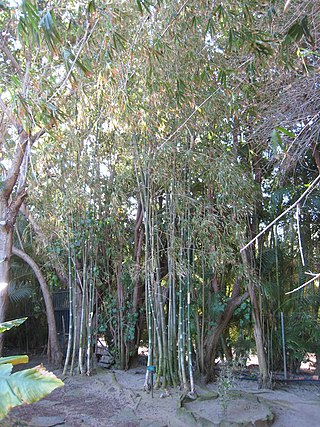
Dioscoreaceae is a family of monocotyledonous flowering plants, with about 715 known species in nine genera. The best-known member of the family is the yam.

Thamnocalamus is a genus of clumping bamboo in the grass family. These species are found from the Himalayas as well as Madagascar and Southern Africa.

General William Munro (1818–1880) was a senior English Army officer and plant collector, botanist and agrostologist. His botanical works included Hortus Bangalorensis and Hortus Agrensis.

Gigantochloa is a tropical Asian and Papuasian genus of giant clumping bamboos in the grass family. It is found in southern China, Southeast Asia, the Indian subcontinent, and New Guinea.

Cephalostachyum is a genus of Asian and Madagascan bamboo in the grass family.
Neohouzeaua is a genus of Asian bamboo within the grass family).

Schizostachyum is a tall or shrub-like tropical genus of bamboo. They are natives mostly of tropical Asia and Papuasia, with a few species in Madagascar and on certain islands in the Pacific. A few have become naturalized in other tropical regions.

Caryocaraceae is a small family of flowering plants consisting of two genera with 26 species. The family is native to tropical regions of Central and South America, as well as the West Indies.

Daphniphyllum is the sole genus in the flowering plant family Daphniphyllaceae and was described as a genus in 1826. The genus includes evergreen shrubs and trees mainly native to east and southeast Asia, but also found in the Indian Subcontinent and New Guinea.

Gompholobium, commonly known as glory peas or wedge-peas, is a genus of plants in the pea family Fabaceae and is endemic to Australia. Most species have compound leaves composed of three leaflets and all have ten stamens which are free from each other and a distinctive arrangement of their sepals.

Oxytenanthera is a genus of African bamboo. Bamboos are members of the grass family Poaceae.
Apocopis is a genus of Asian plants in the grass family, widespread in China, the Indian Subcontinent, and Southeast Asia, including several species endemic to Myanmar (Burma).

Stenotaphrum is a widespread genus of plants in the grass family.
Tulbaghia aequinoctialis is a plant in the family Amaryllidaceae native to Angola. It was first described to science in 1878.

Irvingia is a genus of African and Southeast Asian trees in the family Irvingiaceae, sometimes known by the common names wild mango, African mango, bush mango, dika, mbukpap uyo or ogbono. They bear edible mango-like fruits, and are especially valued for their fat- and protein-rich nuts.

Thomas Powell was a British missionary sent by the London Missionary Society (LMS) in 1844 to Samoa where he remained for 43 years. He was interested in botany, zoology and anthropology and was elected as a Fellow of the Linnean Society of London. During his time on the islands he recorded details of flora, fauna and the culture of the indigenous people.

Margaretta is a genus of plants in the family Apocynaceae first described as a genus in 1875. A dozen names have been proposed as species within Margaretta, but at present only one, Margaretta rosea, is categorized as "accepted" by The Plant List. Most of the rest are "unresolved," in other words, of uncertain affinity. Margaretta rosea is native to Uganda in eastern Africa.
Chydenanthus is a genus of woody plant in the Lecythidaceae family first described as a genus in 1875. There is only one known species, Chydenanthus excelsus, native to Indonesia, Myanmar, New Guinea, and the Andaman & Nicobar Islands.

Maundia is a genus of alismatid monocots, described in 1858. Maundia was formerly included in the family Juncaginaceae but is now considered to form a family of its own under the name Maundiaceae. It contains only one known species, Maundia triglochinoides, endemic to Australia.
Zanthoxylum oxyphyllum is a tree from the family Rutaceae.














